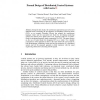Free Online Productivity Tools
i2Speak
i2Symbol
i2OCR
iTex2Img
iWeb2Print
iWeb2Shot
i2Type
iPdf2Split
iPdf2Merge
i2Bopomofo
i2Arabic
i2Style
i2Image
i2PDF
iLatex2Rtf
Sci2ools
95
Voted
SAFECOMP
1999
Springer
1999
Springer
Formal Design of Distributed Control Systems with Lustre
During the last decade, the synchronous approach has proved to meet industrial needs concerning the development of Distributed Control Systems (DCS): as an example, Schneider Electric has adopted the synchronous language Lustre and the associated tool Scade for developing monitoring systems for nuclear power plants. But so far, engineers make use of LustreScade for designing separately single components of a DCS. This paper focuses on the use of Lustre-Scade for designing DCS as a whole. Two valuable consequences of this approach are that (1) the same framework can be used for both programming, simulating, testing and proving properties of a distributed system, and (2) the proposed approach is fully consistent with the usual ing abstractions concerning smooth signals.
Associated Tool Scade | SAFECOMP 1999 | Security Privacy | Synchronous Approach | Synchronous Language Lustre |
Related Content
| Added | 04 Aug 2010 |
| Updated | 04 Aug 2010 |
| Type | Conference |
| Year | 1999 |
| Where | SAFECOMP |
| Authors | Paul Caspi, Christine Mazuet, Rym Salem, Daniel Weber |
Comments (0)

